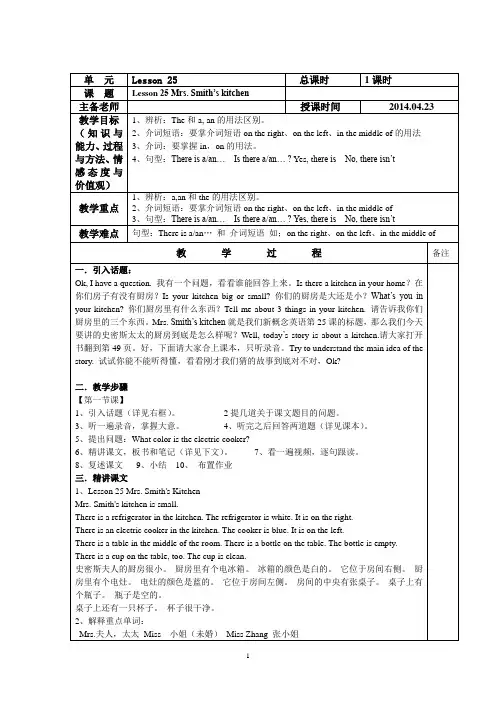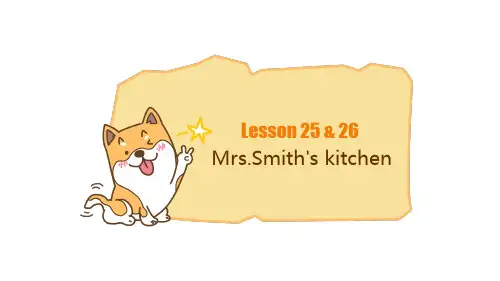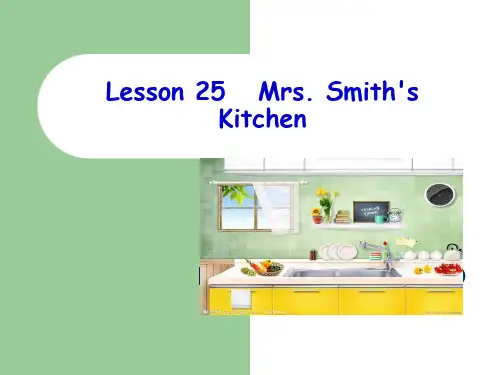新概念英语第一册第25课
- 格式:ppt
- 大小:2.45 MB
- 文档页数:15

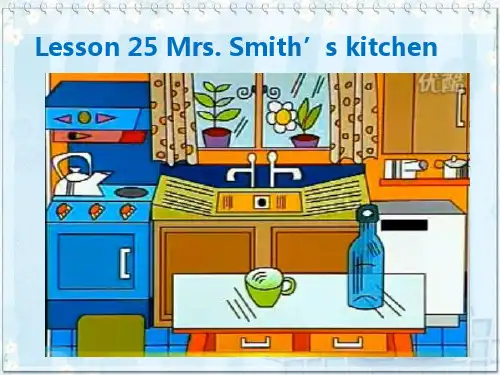
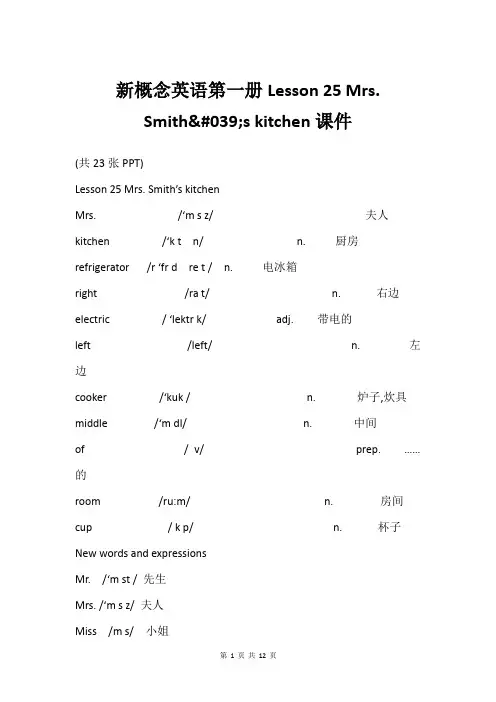
新概念英语第一册Lesson 25 Mrs.Smith's kitchen课件(共23张PPT)Lesson 25 Mrs. Smith’s kitchenMrs. /‘m s z/ 夫人kitchen /‘k t n/ n. 厨房refrigerator /r ‘fr d re t / n. 电冰箱right /ra t/ n. 右边electric / ‘lektr k/ adj. 带电的left /left/ n. 左边cooker /‘kuk / n. 炉子,炊具middle /‘m dl/ n. 中间of / v/ prep. …… 的room /ru:m/ n. 房间cup / k p/ n. 杯子New words and expressionsMr. /‘m st / 先生Mrs. /‘m s z/ 夫人Miss /m s/ 小姐Ms. /m z/ 女士后加姓/姓名注:英语中名在前,姓在后.Tom Green名姓名: first name = given name姓: last name = family name1.(男士)(已婚女士)(未婚)(已婚/未婚女士)*eg:Mr. GreenMr. Tom GreenMrs. Mary SmithMrs. Smithkitchen [‘k t n] n. 厨房2.卧室浴室客厅餐厅书房kitchenbedroombathroomliving roomdining roomstudyinthe在...里refrigerator [r ‘fr d re t ] n.电冰箱= fridge [fr d ] 电冰箱The refrigerator/fridge is white.这台冰箱是白色的.3.eg:4.在右边n.on the right on the left adj.好的,可以的对的,正确的右边的All right.→my right hand = OK.wrong我的右手You are right.→left右边在左边我的左腿my left legleft ofright of在...的右边在...的左边The table is on the left.桌子是在左边。

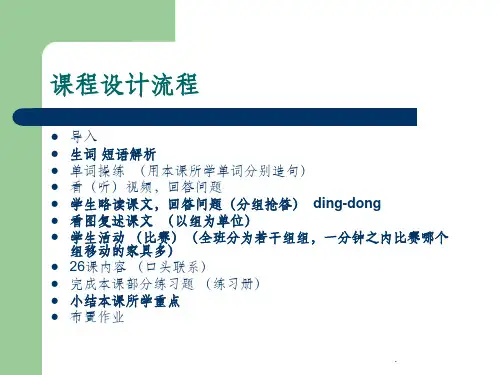
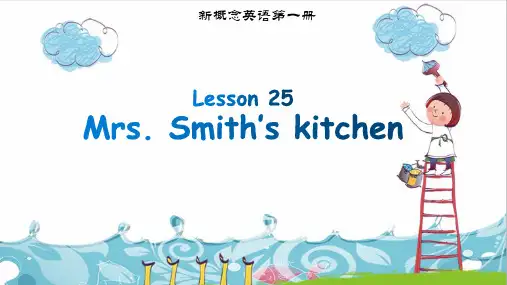
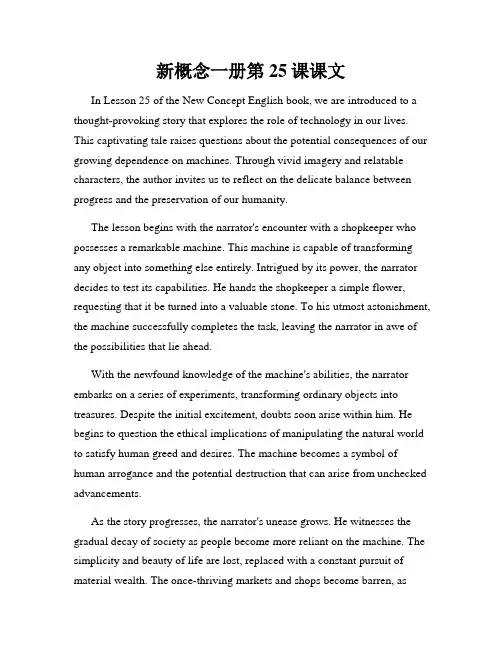
新概念一册第25课课文In Lesson 25 of the New Concept English book, we are introduced to a thought-provoking story that explores the role of technology in our lives. This captivating tale raises questions about the potential consequences of our growing dependence on machines. Through vivid imagery and relatable characters, the author invites us to reflect on the delicate balance between progress and the preservation of our humanity.The lesson begins with the narrator's encounter with a shopkeeper who possesses a remarkable machine. This machine is capable of transforming any object into something else entirely. Intrigued by its power, the narrator decides to test its capabilities. He hands the shopkeeper a simple flower, requesting that it be turned into a valuable stone. To his utmost astonishment, the machine successfully completes the task, leaving the narrator in awe of the possibilities that lie ahead.With the newfound knowledge of the machine's abilities, the narrator embarks on a series of experiments, transforming ordinary objects into treasures. Despite the initial excitement, doubts soon arise within him. He begins to question the ethical implications of manipulating the natural world to satisfy human greed and desires. The machine becomes a symbol of human arrogance and the potential destruction that can arise from unchecked advancements.As the story progresses, the narrator's unease grows. He witnesses the gradual decay of society as people become more reliant on the machine. The simplicity and beauty of life are lost, replaced with a constant pursuit of material wealth. The once-thriving markets and shops become barren, aspeople abandon traditional craftsmanship in favor of the machine's instant transformations. The narrator's personal life is also affected, as his loved ones succumb to the machine's allure, neglecting human connection in pursuit of material gain.In the final scene, the machine malfunctions, bringing the narrative to a climactic conclusion. Its abrupt breakdown symbolizes the limits of our reliance on technology and the dangers of forsaking our humanity for convenience. The narrator, now recognizing the detrimental impact of the machine, reflects on the lessons learned and the importance of finding a balance between progress and the preservation of our values.The underlying message of this story is clear – as we embrace technological advancements, we must also safeguard our humanity and the essence of what makes us human. It is a cautionary tale, warning against the blind pursuit of progress at the expense of our intrinsic human qualities. Through powerful storytelling, the author urges us to foster a harmonious coexistence between man and machine, where technology serves as a tool rather than a replacement for our deeply rooted connections to one another and the natural world.Lesson 25 of the New Concept English book leaves readers with a profound reflection on the potential dangers of unbridled technological advancement. The story serves as a reminder to tread carefully, considering the impact of our actions on both ourselves and the world around us. By acknowledging the risks and seeking a balance between progress and human values, we can navigate the path of innovation with wisdom and empathy.This timeless lesson continues to resonate today, as we navigate an ever-evolving landscape of technology and its impact on our lives.。
